After all the grumbling and accusations I’ve heard from critics of the Church over the City Creek Center (the big new mall in downtown Salt Lake City), I put on my spiritual flak jacket and went to downtown Salt Lake City during a brief visit to see the tragedy for myself. My testimony somehow came out unscathed. OK, it helps knowing a little about the purpose of the Mall (giving back to the community to create jobs, reducing urban blight, and making the downtown Salt Lake City area hosting Church headquarters more vibrant and healthy) and the facts about the money (not tithing money). But there’s nothing like seeing, and tasting, for one’s self. I really enjoyed the visit, though I’m not into shopping and mall scenes. But this is much more interesting than just a mall. It’s a beautiful, innovative, artfully landscaped and designed center that makes the downtown much more of an attraction. I asked an ex-Mormon friend who is a successful and highly connected businessman what he thought of the Mall. He gave it a thumbs up for having a strong positive impact on the economy. Looks like the mission is being accomplished. Lots of people having fun and lots of employees having good work. Not bad.
Here are a few photos. More photos are on my webpage at www.jefflindsay.com/salt-lake-city-photos.html. Click to enlarge.

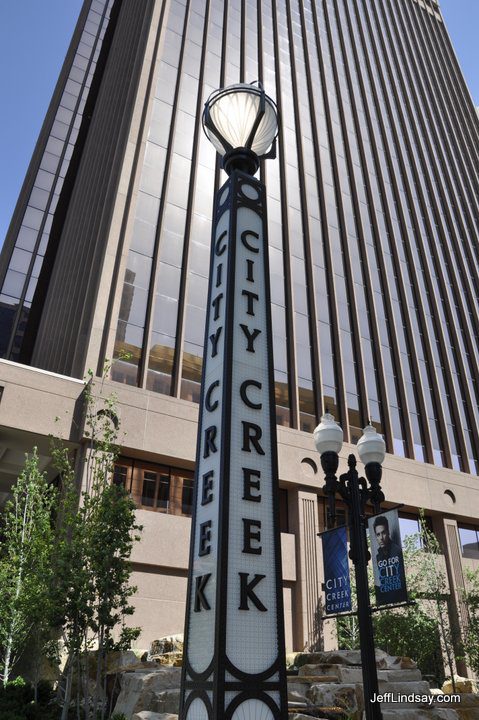
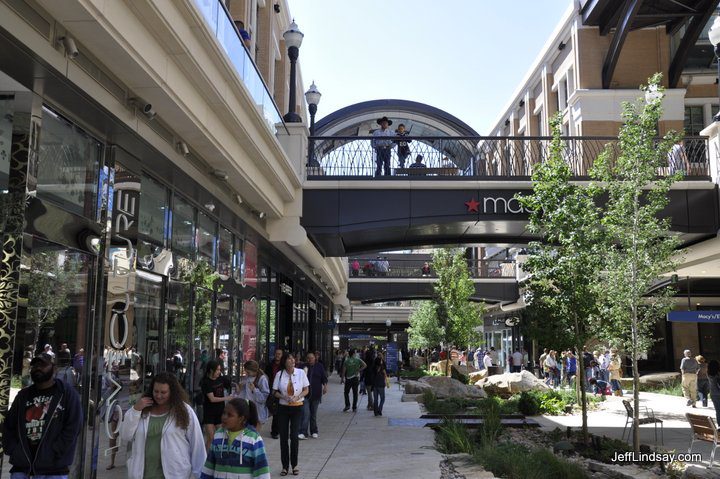
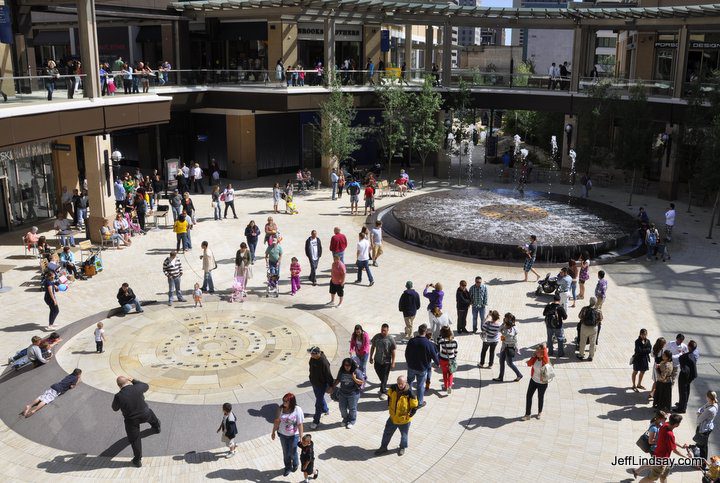
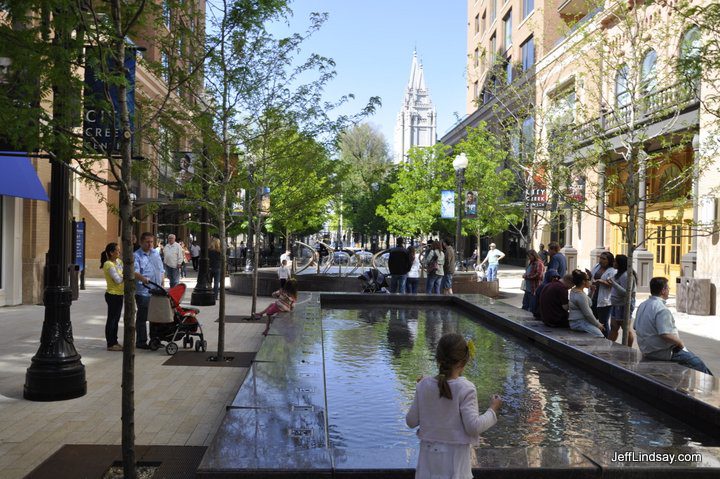
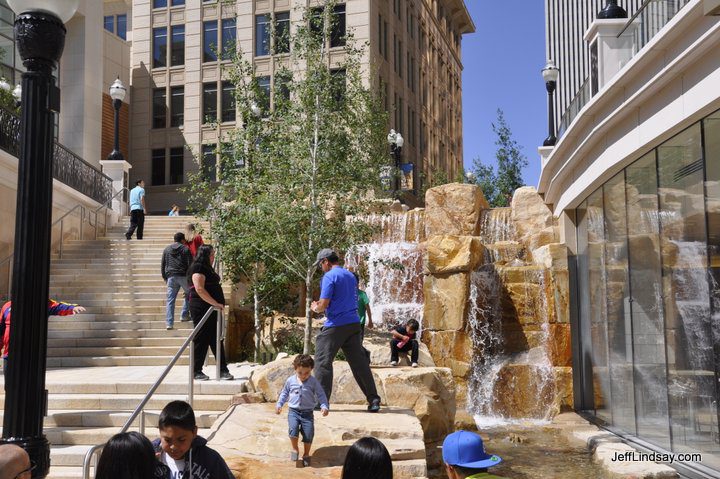
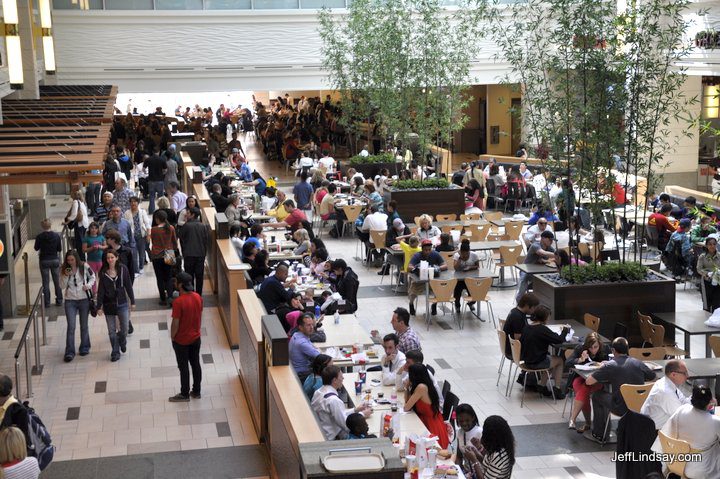
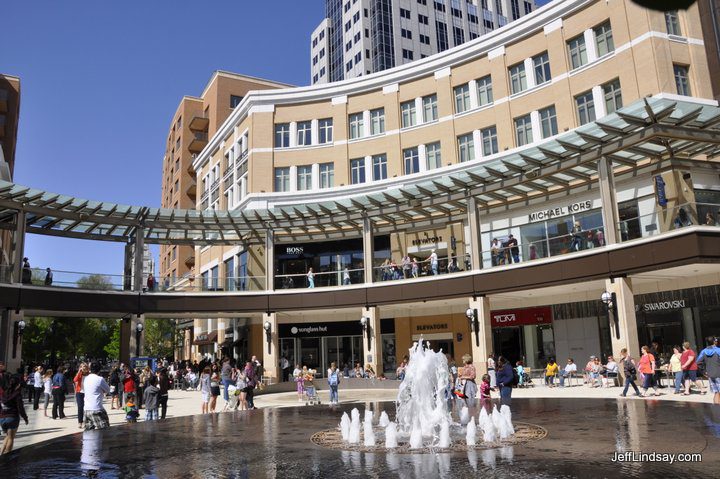
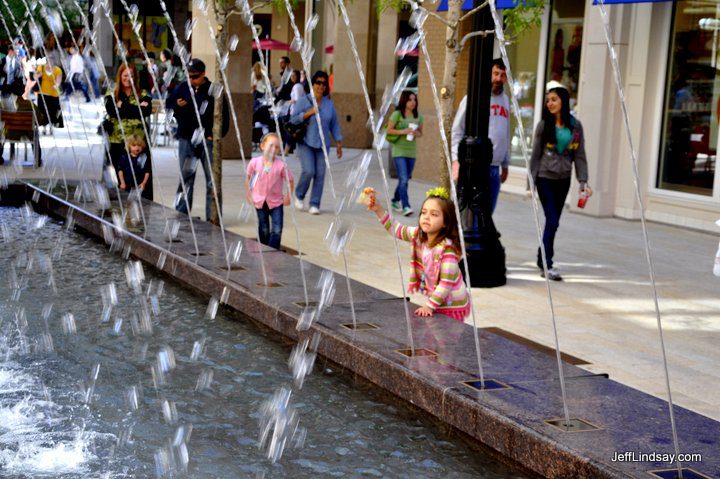
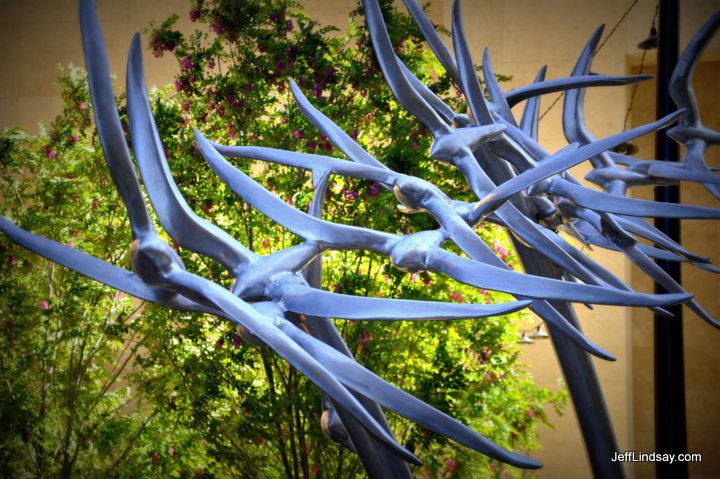








Where did the non-tithing money come from? Isn't this just semantic spin, doesn't all church income eventually track back to a donation of some kind?
Well, the funds apparently come from the the church's for-profit real estate development arm, but since money is fungible I too wonder about the distinction.
I, too, was at the new City Creek Mall this weekend for the first time. Having previously lived in SLC working in the real-estate development arena, I also connected up with a former colleague of mine, an architect in SLC. She expressed concerns that SLC may not be big enough to sustain two large malls so close to each other. She is Catholic and has lived her entire life in SLC. She has noticed a significant decline in the business at the Gateway Mall and fears of eventually one or the other of the two malls going under. I also am concerned that, since all money for the Church originally came from donation of some kind, that donation money was invested somewhere, sometime by the Church and then the profits used to help finance this project. I don't know how to check these accusations, but it only seems logical that if Church money was used, that it must have come from donations, as that's all the money the church has.
Jeff, thanks for your post and review. I guess I share Joseph's concern about whether SLC is a big enough market to support two such similar malls in such close proximity. I guess time will tell, but it would be sad to see one or the other of them fail.
Not having a strong opinion either way, I thought the critics were critical because of what was already said in the comments and also for a desire for tithe money to be spent more on charitable projects, like in olden days, also to have the money decisions be brought back to the members (or at least a public accounting) of money to be shown to members, since currently it is all shrouded in mystery contrary to early church practices.
I can see these as valid concerns since tithe money is a large chunk of ones income and it is seen as mandatory for people to pay it (like hell fire if you don't). I think a cure to these problems would to say that tithe money needs to be given to any charitable organization that one desires and they would be considered full tithe payers (more like a free market). OK, now I'll hold my lightning rod now so I won't get burned to badly!
…lots of employees having good work. I'm not sure what you mean by this comment but this project does not create any significant number of new jobs except for the temporary construction jobs that built it. Was there a shortage of retail, commercial or residential space in SLC that was constraining business? I don't think so. This is more of a "if you build it they will come" boondoggle.
Last month I flew from Florida to Salt Lake for a wedding. I had not visited Salt Lake since they first knocked down the old ZCMI and Crossroads in 2008.
On my last visit to Gateway I found it very nice. It was slightly out of the way when one is visiting downtown but it is an appealing shopping area.
My impression of City Creek is that it is trying too hard to bring a standard mass-market set of "lower upper income" shops to an urban core. I found nothing unique or especially appealing about the variety of stores. They are the same stores you can find in any suburban location. I also believe that it will be difficult for both Gateway and City Creek to survive so close together.
If the church wants a strong, vibrant, urban core in Salt Lake it cannot be afraid of fostering local businesses and allowing for organic growth with all its warts, variety and excitement. A downtown with a strong residential population will create its own vibrancy and nightlife. What they have created in Salt Lake is not an urban environment but is a Disneyfied version of a suburban upscale shopping center placed in a downtown location. It does nothing to make Salt Lake a more interesting or exciting place. There is no reason to go downtown if one can find the same stores, restaurants and demographic population in the suburbs.
I really think that we, as Latter-day Saints, are projecting our white-bread brand of church culture onto downtown Salt Lake. I don't see it attracting the people that make urban centers exciting or sustainable. Where is the room for the creative class?
P.S. What is with the words "private property" on every single sign at every single entrance to the City Creek property? It is really disconcerting and reminds me of the overly-strict treatment of visitors imposed on the closed off road in between Temple Square and the Church headquarters building.
If you read the information at the links Jeff gives in the OP, you'll see some of the financial reasons that make the invenstment in City Creek a good thing.
Non-profit organizations that rely on donations (especially large churches) NEED income-producing assets as a hedge against a drop-off of donations in hard economic times.
The church owns many income-CONSUMING assets such as chapels and temples. Owning income-PRODUCING assets is insurance that the chapels and temples will be able to be maintained if tithing and other donations drop off.
These kinds of investments, in businesses and especially income-producing real estate, are STANDARD PRACTICE among large non-profits which have professional financial management.
Sorry but this is a shell game you're playing Bookslinger, chapels and temples are income producers. They are built for and used by tithe payers. It's fine with me that the church owns profitable businesses but if you track non-tithing sources back to their genesis you will find they came from some kind of donation. So called "non-tithing" funds is misleading and obscuring the facts.
Yup! Looks just like a mall. There aren't enough of them in the world…
Howard, so what? The accusation that it's "tithing money" is still a red herring.
It's the same with ALL non-profits. ALL their assets originally came from donations, or interest or investment return on donations.
The main problem with the critics is the demand that 100% of donated income has to go back out the door, and that the organization can't build up RESERVES and ASSETS as it grows. That's just plain ridiculous, and is not practiced at any other major long-existing charity that is still growing its income CONSUMING assets such as chapels and other needed buildings.
Such a demand can only be achieved at non-profits with relatively few fixed assets, and where their staff and program expenditures can _immediately_ be cut back in lock-step with changes in donated income. Churches, or any growing organizations who plan on being around for generations, and continuing to build chapels, can't do that.
As long as the LDS church has a growing membership, and a growing need for new chapels, especially outside of the US where church money flows -to- instead of -from-, there is a financial NEED, even a MANDATE by generally accepted big-organization financial management principles, to GROW the "reserve" of income-producing assets.
And, sorry, LDS chapels and temples are still classified, as all other churches do to theirs, as income CONSUMING assets. They aren't rented out. There is no admission charge. Tithing is not required for church attendance. Chapels just cannot be "sold off" or dumped, if a congregation stops paying tithing.
In fact, in many wards, only about 50% or less of active/attending adult members actually pay tithing. And in 3rd world countries, there's a net inflow (us to them) of church money. Their tithing is not sufficient to build, nor probably maintain, their chapels and temples.
Just heating and cooling of a -small- chapel in Indianapolis, told to me by the church's local architect, runs an average of $3,500/month, or $42,000/year. Add in maintenance costs (replace carpet/pews/furniture every once in a while, paint, etc.), and amortize the cost to build it over 40 years or so, I doubt the tithing generated by the inner city ward and two branches that meet there (or 2 inner city wards in another identical chapel) come close to paying the total costs associated with those chapels.
Bookslinger check with your Ward Clerk less than 15% of the tithing collected is used for local buildings and congergations. It would require an unprecedented drop in donations to create a serious problem. With Temple building slowing and $Billions being invested in urban renual I would say that the income is overwhelming the need for church buildings. In addition it's hard to argue illiquid urban bricks and mortar make good emergency reserves for other illiquid brick and mortar assets.
Imagine what else could have been done with even some of this money, it could have been used to save lives. I sponsor an African AIDS orphan it only costs $80.00 per month to cover all of his needs including schooling. I contribute to H4O an organization that donates clean water to third world villages at a cost of only $10,000 per village of 3,000 people. It's a joint effort the villagers build a structure to house the donated water filtration system. These are great solutions and they are not expensive.
Bookslinger's point has some implications towards charity.
Namely that producing money through investments like this mall (and others, because there are definitely other income-generating ventures the church takes on) leaves more money for charity and expansion.
The tithing money spent is recovered. Then, even more money is generated because it was invested.
Leaves more for charity. Leaves more in general.
The controversy would come from money not actually being spent on charity, but the church doesn't release its financials. So who knows. Either way, the mall was a smart (unless the future proves otherwise), well-intentioned investment. Just like the church's other investments.
How silly of Jesus to advise the rich man to sell his possessions and give the money to the poor. What an outdated model of charity! Better the rich man should take the family shopping at the mall, so that the church that owns the mall will make a profit and give some of that profit to the poor.
Jesus just didn't get the beauty of consumerism. Thank heaven we know better today.
OK, seriously, the mall looks beautiful. And I get the idea that nonprofits can engage in profit-making enterprises in order to leverage their donations and enhance their ability to do good. The deeper criticism, it seems to me, has to do with the degree to which a church should intertwine itself with commerce. The greater the extent to which a church's ability to fulfill its mission depends on the success of a shoppers' emporium, the more its spiritual interests are yoked to an outside set of material interests. The church now has an interest in promoting consumerism, in encouraging people to go out shopping, for Jesus. The materialistic values of the world do not always conflict with the spiritual values of the Church, but in many cases they do. A church that owns a mall would seem to be violating that old maxim that a church should be in the world but not of the world.
Openminded brilliant! Extending your logic; if the church gave nothing to the needy instead investing it all they would have even more to give the needy!!! Why didn't I think of that?
You were probably just distracted by a great and spacious building.
Howard, you just really badly want to win this one.
That's not "extending" my logic, that's trying to find a slippery slope that doesn't exist. If you're trying to pretend there's no logic at all to financial investing, then I guess some people just want to go against decades of proof to the contrary. have fun.
And as per your claim of consumerism, Anon, take a look at Bill Gates and Warren Buffet. They're providing more charity to the world than the LDS church can possibly match these days.
It's like they got rich off of consumerism and made the world a better place afterwards, or something.
Whole lot more transparency from Bill Gates and Warren Buffet and I'd bet a much higher ratio in income to charitable enterprises. I'd also be willing to bet there's a clearer charitable relationship that doesn't seek to be self-serving in the process.
Openminded I'm pointing out the irony of your position. Slippery Slope? OMG, how long should people continue to die of malnutrition, thirst and easily curable disease while the church drags it's feet trying to get comfortable with the idea offering more than just token aid? I'm arguing given the $Billions spent on CCC temple of spending we are well past that time. If not now, WHEN?
I'd love for them to be more transparent about their funds, of course. And I think it'd do a lot of good for the charitable side (or rather, for bringing it out).
I don't pretend the billions of dollars couldn't have been spent better for charity, I guess we were just arguing different points.
I don't mean to make a broad, overgeneralized political swipe, but the church seems about as out of touch towards reality in this respect as Mitt Romney has in his overall campaign
Howard, you're still not seeing the big picture. Yes, in currently affluent wards, maybe 15% comes back for local building maintenance. But not all wards are affluent, especially outside of the US.
But the big need for a reserve is the possibility of a widespread drop-off in tithing income for the church.
A widespread drop-off doesn't have to come from people deciding to stop paying tithing. It can come from an economic downturn, like what started in 2008, when unemployment spikes, and even the employed have reduced incomes.
From what I hear from a full-time employee of the church, the church suffered a big decrease in tithing income starting around 2008. And in addition to more members being unemployed, and members earning less, there probably were some who also decided to not pay a full tithe.
And with the economic downturn, came more members applying to their bishop for church welfare. THAT is also a HUGE expenditure for the church that also increased significantly starting in 2008.
A member who has zero income and pays zero tithing is still considered a full-tithe payer, because 10% of zero is zero. So they can still hold a temple-recommend, and there still can be enough temple-rec-holding priesthood to run a ward. So they can't just sell off the building and close the ward during an economic collapse.
The church has about 14,000 chapels to maintain around the world. That is a LOT of property. And there are scores, or even hundreds of new chapels being built every year.
I forget the exact number, but chapels are broken down into regions of about 10 stakes, and each region has two full-time employees in Facilities Management, who oversee the contractors and volunteers who clean and maintain the buildings.
It is new chapel construction, along with the growing maintenance costs that consumes most of that 85% "excess" tithing that is produced by the affluent wards.
We don't know the exact amount, but it's also been said that Fast Offerings also don't come anywhere near supplying all the funds for church welfare. Much of church welfare comes out of tithing.
And let's not forget the cost of maintaining 340 missions around the world. 340 mission homes, and close to that many mission offices (which are usually separate from the mission home.)
And having 55,000 missionaries serving 1.5 to 2 year missions means buying about 28,000 round-trip air-fares every year.
Plus most of the foreign missionaries are supported by the central church, not their families or home wards.
And let's not forget BYU, with campuses in Provo, Idaho, and Hawaii. Those are also huge income-consuming assets, with members effectively getting a subsidy on tuition.
Plus all the full-time CES instructors and administrators, there are a lot of salaries there.
Plus the CES buildings; the Seminary buildings built across the street from public schools in Utah, to the Institute buildings built on just about every large US college campus. Those either have rental costs, or construction/amortization/maintenance costs.
The bottom line is that the church, as any multi-generational, non-profit, large-asset-owning, continually growing corporation, needs a huge reserve of income-producing assets.
Aside from that, if one is to argue against the church's investment in City Creek, one would effectively be claiming that the church either lacks professional financial management, and/or the prophet lacks inspired direction.
I'm very confident that the church has both very professional financial managers working for it, and an inspired prophet.
Books linger,
I stand by my previous comments. Of the more than 85% of tithing dollars that are not used locally more are spent on new building projects than church operations. $Billion malls do not provide liquid reserves during economic downturns. During economic downturns operating cash is increased by slowing building not accelerating it.
Yes, because we've all seen the great track record of inspired prophets. I guess it depends on when they're acting as a human instead of a prophet, which no one has a grasp on. Smith definitely was acting as a human in the Kirkland Bank disaster.
I'd have a lot more faith in the financial planners if I were you
Wow, I'm a first timer and was somewhat surprised at the proportion of pro-LDS and not here- Mr Lindsay has apparently done a good job at making his blog "not just for Mormons".
I think that City Creek will lose money in the short and medium term, considering that it was approved just before the downturn and that Taubman takes their profit off the top. I see it as basically being built because President Hinckley suggested it and Bishop Burton had worked a decade on it. I hope that the housing market picks up and the rest of the planned housing can be built and sold- that will represent a real downtown renaissance. For now I agree that City Creek is basically an upscale destination mall that hopes to attract people from a wider region for fancier stores. This is very in line with Taubman philosophy, though not particularly reflective of LDS philosophy. I think LDS basically decided "yes, we want a project like this and we have the money set aside for it, let's get the best partner with know-how that we can find" and then basically handed Taubman the reigns and said "please be closed Sundays".
I agree with the notion that at some point this money was connected to tithing or donations, but I disagree that it's inappropriate for the church to decide how to spend it. It is, after all, a donation, and the church doesn't make decisions by vote (though it does sustain leaders that make those decisions). City Creek with be a boon for Salt Lake when they needed it, and if the housing works out it will help long term, if not it will just be another gateway that's a bit out of the way for more people but adds to the city. It's certainly better than Crossroads and ZCMI- malls were already there so people shouldn't complain that they were updated.
In the end, SLC benefits like DC does for being headquarters to a large organization that takes funds from a wide area. I think the project is mostly a gesture to Salt Lake to say "hey, we're still here and still want to be a big part of this city", as well as a perhaps-overoptimistic attempt at financial investment, foiled by major recession.
I respect LDS's sovereignty over their own funds, acknowledge their presumed desire to trust their experienced partners at Taubman for the perhaps-over-the-top-to-"beware of pride"-LDS design, and am doubtful that it will be a major financial success even in the long run. Enjoy the birthday present SLC, and stop complaining anyone else.
I don't have any problem with the Church contributing to build a mall. There are a lot of Church standards in place and it does, as you said, give back to the community. The Church helps the poor and the needy all over the world. It's nice that they are helping provide jobs downtown and to beautify it. I don't live in Utah anymore, but when I go back to visit SLC this winter, I am going to go take a look at it. My only real complaint is, and it's a mild one, that it doesn't have any bookstores I am interested in. So, I hope Gateway coexists with it.
The church is totally within it's rights to spend it's money that was donated as it sees fit.
I think what many people are raising a question about (and why do we have to label anyone that has a critical question about it as an "ex-mormon"? Jeff the article you linked to was using a lot of ad-hominem attacks) though is that the church does seem rather hypocritical. It is very quick to toot it's own horn about service it does (and maybe I'm mistaken but aren't those efforts funded by the separate "humanitarian aide" fund?) but yet it seems to throw a whole lot of money at projects that it sees as profitable (which is doubtful in this case.)
Basically what I'm getting at is that I can see more "christlike" behavior in some small, local, secular non profits than what seems to be apparent from the LDS church. For people the believe it to be the one tethering point in our mortal world with the deeds and intents of Jesus Christ himself that may be a bit disconcerting.
Of course maybe that assumption is off base as the LDS church does not publish any of it's finances, and maybe it's also unfair for me to assume things.
Mateo-
"Assume" is all anyone can do since the church doesn't disclose anything about its operations. Even so, it's pretty apparent that what they do in the way of humanitarian aid is dwarfed by every estimate of their tithing income — which, of course, is only a part of the income that also comes from fast offerings, income producing assests and who-knows-what else? (emphasis on who knows 'cause they've designed it so none of us do)
Howard said…"I stand by my previous comments. Of the more than 85% of tithing dollars that are not used locally more are spent on new building projects than church operations. $Billion malls do not provide liquid reserves during economic downturns. During economic downturns operating cash is increased by slowing building not accelerating it."
1. Whether the majority is spent on new building or operations, you'd complain about it anyway. My point still stands, both operations AND construction of new chapels has to occur if tithing were to ever drop off drastically for a long period, and income-PRODUCING assets such as malls help ensure against that.
2. Who said anything about LIQUID reserves? I said RESERVES. The mall is not intended to be a LIQUID reserve. There are plenty of reasons for ALL KINDS of reserves. Other multi-generational institutions, whether churches or insurance companies, invest in income-producing real-estate as a way to park a good portion of their reserves. Stocks and bonds are other places where reserves have traditionally been parked.
3. The need for income-producing assets is not just for the current economic downturn. I'm talking about a possible BIGGER or a very long term downturn in which the _revenue produced_ by such income-producing assets is used for church operation and growth.
The reserves of a church are like an "endowment", a term used by many non-profits, usually schools. In a growing organization, it is important to NOT spend down the endowment, but rather to invest it wisely, and use the income it produces.
You've also apparently made some assumptions that the money put into City Creek came directly from current tithing. Perhaps it came from some liquid assets that had been liquid too long, or stocks that needed selling off. We don't know.
I just know that all your arguments are based on, not only assumptions, but a false understanding of how large multi-generational institutions work.
You'd disagree with the church no matter what it did. And I'd support the church no matter what. So in effect, why are we arguing?
Openminded said…"Yes, because we've all seen the great track record of inspired prophets. I guess it depends on when they're acting as a human instead of a prophet, which no one has a grasp on. Smith definitely was acting as a human in the Kirkland Bank disaster.
I'd have a lot more faith in the financial planners if I were you"
FYI, at the time of the failure of the Kirtland Safety Society (bank), there was a big depression in the country, and many banks and financial institutions went under all around the country. It wasn't just an LDS thing.
Also, for all we know, both internal and 3rd party financial experts gave the church the go-ahead on the SLC mall investment.
"It wasn't just an LDS thing."
So you can't tell the difference between ordinary man and Joseph Smith in this situation.
It's like the inspired prophet part didn't even play in, which is exactly the point I was making.
Even Smith couldnt use his prophetic powers for any good in finance, why should we expect today's inspired prophets to be any better?
probably because, yeah, there were likely some 3rd party financial experts out there.
@openminded,
"So you can't tell the difference between ordinary man and Joseph Smith in this situation."
Well, ya see, prophets are mortal men called of god so sometimes they speak with the power of god and sometimes they speak with their imperfect opinions. Unfortunately, until they install a "speaking as a prophet" device under the podium that lights up when they are doing so it will always be decided years and years after it was stated, once there's no longer any danger of being wrong.
Like how Brigham Young made horribly racist comments about black people to justify why they can't have the priesthood. Now that Civil Rights have been successful and that such ideas are seen as racist we can safely say that he was speaking as an imperfect man.
Oops! Maybe it will prove to be an inspired use of the church's assets and energies but it's hard to project when it will prove to be a good business decision when they've had to give away 5 years of free rent to get Apple to open a location in SLC.
http://news.yahoo.com/blogs/technology-blog/apple-being-offered-free-rent-just-open-stores-220105575.html
The Deseret Ranch in Florida is a for-profit operation. Nothing that's done there is for the benefit of the church or its members. It's purely for profit. Go visit, and they will tell you this in the visitor's center.
That said, it's really sad the compromises the church has made at City Center. Alcohol is served on the premises, and several restaurants are open on Sunday. What a horrible message to send!
I work downtown, and I don't think the size and scope of the mall is sustainable. I've spent a bit of time on the site, and have yet to buy something, and most of the crowd is there to see the place, not to shop.
Thanks for the pictures, I haven't seen it yet.
Firstly, it seems that a lot of people here (particularly Anons) don't understand basic business principles. To say that a donation based organization should have no investments or should not attempt to build assets is ignorant while that philosophy would be failing and foolish in any organization. I would remind some individuals that the church has suffered enormous oppressive debt in the past due to poor business practices. I believe that this has motivated the church to adopt more practical business practices such as investments and for-profit activities as fail-safes and as tools to further the capabilities of the church in achieving it's goals.
There are some understandable knee jerk reactions when we are talking about non-profit organizations having tied up money. This is due to some corrupt pyramid organizations that fill the pockets of the few. However, we must remember in this case (as is shown in the OP) that the for-profit arm of the church is not doing this. We should look at the motivation for such investments; Is this investment to line individuals pockets now or in the future? If so who?
I believe that the biggest moral question on this matter is a question of motives. Why did leaders in the church decide to invest in this mall? I do not believe that the investment was made to make any individual(s) rich, I believe it was made to help fulfill the goals of the LDS church which is ultimately to bring people to Christ and to know him more perfectly. While it is fine to question if this was a wise investment or not, I don't think we can say the motives are for the benefit of the leadership.
Firstly, it seems that a lot of people here (particularly Anons) don't understand basic business principles. To say that a donation based organization should have no investments or should not attempt to build assets is ignorant while that philosophy would be failing and foolish in any organization. I would remind some individuals that the church has suffered enormous oppressive debt in the past due to poor business practices. I believe that this has motivated the church to adopt more practical business practices such as investments and for-profit activities as fail-safes and as tools to further the capabilities of the church in achieving it's goals.
There are some understandable knee jerk reactions when we are talking about non-profit organizations having tied up money. This is due to some corrupt pyramid organizations that fill the pockets of the few. However, we must remember in this case (as is shown in the OP) that the for-profit arm of the church is not doing this. We should look at the motivation for such investments; Is this investment to line individuals pockets now or in the future? If so who?
I believe that the biggest moral question on this matter is a question of motives. Why did leaders in the church decide to invest in this mall? I do not believe that the investment was made to make any individual(s) rich, I believe it was made to help fulfill the goals of the LDS church which is ultimately to bring people to Christ and to know him more perfectly. While it is fine to question if this was a wise investment or not, I don't think we can say the motives are for the benefit of the leadership.
There should be total transparency in non-profit money collections and expenditures and no exception should be make for churches. No honest man could protest such a thing.
As an atheist, I get a lot of entertainment value reading over the arguments as to whether building this modern Tower of Babel cum Money Changer Castle is something that would please or displease imaginary Jeebus. Like so many other historically contentious Mormon issues, it all depends on what angle you hold the Book of Mormon and exactly how you squint at it as to whether or not you can 'see' the spiritual wonder of Corporate Capitalism. At the end of the day, be thankful the Mormon leadership is just saddling you with some questionable real estate investments and not trying to wrestle your wife or 14 year old daughter away as the upteenth wife of Smith or Young. These young Mormon whippersnappers don't know how good they have it these days.
Enjoy.
I am an active LDS member that is totally okay with the church having financial holdings and companies. In fact, this allows the "brethren" to be funded without it coming directly from tithing (aka filthy lucre). President Hinckley explained some of this below…
https://www.lds.org/ensign/1985/11/questions-and-answers?lang=eng